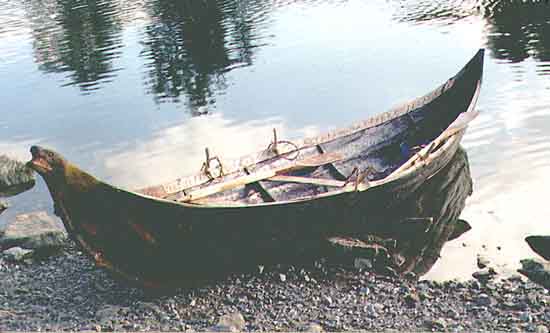Testing of the reconstructed boat on water
 Boat launched.
Boat launched.
|
The boat measures approx. 6.5 m length, 1.35 m maximal width, 40 cm maximal depth. She
weights
around 100 kg, two men can lift her and carry.
Лодка имеет длину приблизительно 6.5м, наибольшую ширину 1.35м, глубину 40 см.
She behaves in a rather unusual way on water, in comparison to modern crafts.
At first one feel scared , as the boat is extremely weak and unstable. The bottom is so thin,
that it is better to step onto the ribs or on the exact
middle over the false keel. It is difficult (and dangerous!) to keep balance when standing
upright in so unstable a craft, and, if the balance is lost, it might be disastrous to
recover it by
a sure hard sideways step -- your foot might go right trough the weak bottom.
Nevertheless,
after some half an hour one would get used to this behavior and starts to see her advantages:
as always, her strength is in her weakness -- the boat is very light on oars, it is
possible
to row at almost 6 kph speed for hours. Perhaps, speed of walking ca. 5 kph plays some threshold
role
with human perception, when a boat is rowed below it, one feel working too hard and moving too
slow, but, surpassing this speed, he starts to feel cheerful and like going further and further.
Longest journey was 30 km long on map, done in less then 6 hours without much exhaustion.
When the rower is properly seated, the boat becomes stable enough and quite seaworthy --
with her lightness and high freeboard tall waves from big ferries passing close seem to be no
danger. There were two leaking cracks in the bottom from the beginning, which were stopped
with spruce gum. Periodically they started to leak again, but, thanks to the boat lightness
water pressure is not so high, and it was possible to stop a crack again on water.
In some emergency case leaking would not be so fast even through a big hole, and the boat would
be able to reach closest shore.
 Stern view
Stern view
|
Another advantage of lightness must become apparent if a boat has to be dragged over
some land track, between different river systems, or bypassing rapids. It could be a crucial
point with this type of boats, but no such experiments were done yet.
Such a fragile boat would certainly be damaged sooner or later against some rocks, and
will need a repair. The original had as many as four big cracks in the bottom, their length
up to 4 meters. They were patched with thin wooden lathes, sewn
from inside. (Though, it is not clear how those lathes were inserted between ribs
and hull, as they were. Either the bottom cracked during
expanding and
was repaired before ribs were fitted in, or the boat once underwent serious repair with her ribs
taken out.) Anyway, it seems that her ancient owners used to take damage and repair easy,
as something inevitable, and were sure to find all the necessary material -- such as
roots, moss, and wooden sticks right near the place of accident. Of course, one have to keep
a bailing bucket always in the boat, and have some tools, a knife, at least, and
caulking material, moss and tar or gum.
 Boat launched.
Boat launched.
 Boat launched.
Boat launched.
 Stern view
Stern view